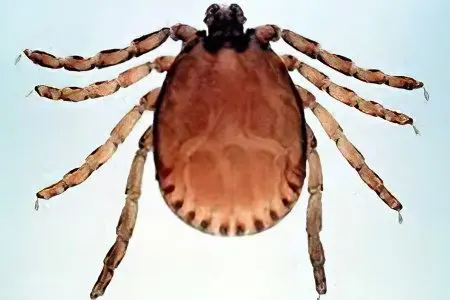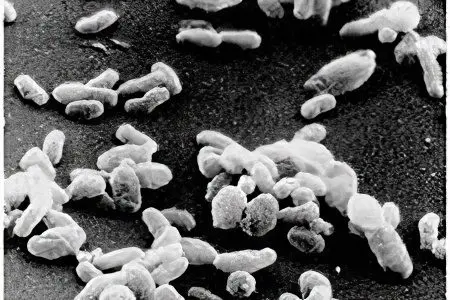Contents
Description of the disease

Typhoid fever – This is a disease of infectious origin from varieties of rickettsiosis, caused by tick bites, characterized by a relatively mild course with damage mainly to the lymph nodes and skin rashes. Other names of the disease that are found in medical practice and everyday life can be: tick-borne rickettsiosis, Siberian tick-borne typhus, oriental typhus.
The disease belongs to typical zoonoses, because the circulation of the pathogen and the incidence is recorded only among small rodents in natural conditions. It can be gophers, hamsters, field mice, chipmunks, voles. A person falls into this natural circle by accident after a tick bite. Therefore, tick-borne typhus refers to diseases with natural foci and is tied to certain areas where pathogens constantly circulate. These are some regions of Siberia, Krasnoyarsk, Khabarovsk, Primorsky Territory, Turkmenistan, Armenia, Kazakhstan, Mongolia.
The carriers of infection between healthy and sick animals are ixodid ticks. The prevalence of the disease in natural conditions is so wide that every fifth representative of ticks is infected. This explains the relatively high incidence of tick-borne typhus among people living in pandemic areas. It averages 200-300 cases per 100 population per year. A significant number of residents have strong natural immunity, so mostly visitors and people with weakened immunity get sick.
The pathogenesis of the disease is determined by the pathogenic properties of rickettsiae. They enter the human body through the skin wound that remains after a tick bite. This place is called the primary affect, since the first inflammatory changes occur here when tissues come into contact with pathogens. In this case, pathogens spread along the lymphatic tracts to the collectors of the lymph nodes of the regional order. The result of such processes can be lymphangitis next to the primary affect, and an increase in lymph nodes. In them, rickettsia multiply with regular release into the systemic circulation and spread throughout the body.
The peculiarity of infectious agents in tick-borne typhus is the preservation of tropism for the vascular endothelium, as in epidemic typhus, but much less pathogenic and toxigenic properties. The main pathogenetic links of the disease are microcirculatory disorders as a result of capillary damage, inflammation in them and increased permeability, as well as minor intoxication that occurs when pathogens are destroyed by the body’s immune cells. Therefore, their distribution in the body proceeds relatively favorably and never causes severe complications.
Symptoms of tick-borne typhus

The period of incubation of pathogens of tick-borne typhus, which lasts from the moment the tick bites until the first manifestations of the disease appear, ranges from 3-4 days to a week. At this time, in addition to a slight inflammation of the skin at the site of the bite, nothing bothers the patients anymore. The clinical picture develops suddenly and quite sharply.
In this case, the following symptoms of typhus appear:
hyperthermic reaction. In most cases, the temperature is hectic (39% C or more), constant or intermittent. The duration of the febrile period can be up to two weeks if the patient is not treated. A few days after the appearance of the temperature figure decreases slightly, it acquires constancy;
Slight chill with muscle and headache. Occur synchronously with hyperthermia and decrease with its decrease;
Moderate puffiness of the face against the background of its hyperemia;
Infiltrative-inflammatory changes in soft tissues in the area of a tick bite – the primary affect. It should never be after a tick bite that is not infected with pathogenic rickettsiae. The bite site itself turns into a small ulcer under a black scab, and around it there is a 2-3 mm strip of skin hyperemia;
Hyperemia of the conjunctiva and oropharyngeal mucosa with enhanced and congestive vascular pattern;
Skin rash. It is represented by a true polymorphism of primary elements: roseola, small papules, spots, up to several millimeters in diameter. Their appearance is noted 4-5 days after the onset of temperature. Characterized by constant additions of new elements. Hemorrhagic rash is not typical. The first rashes appear on the skin of the extremities, from where they spread to other areas;
Enlarged lymph nodes, primarily regional in relation to the bite site;
Tachycardia or bradycardia. Arrhythmias are rare. Blood pressure may decrease slightly;
Symptoms of damage to the nervous system: lethargy, headache, apathy, sleep disturbances. Confusion and meningeal symptoms are extremely rare.
The causative agent of tick-borne typhus

Tick-borne typhus is caused by pathogenic microorganisms from the rickettsia group. Their specific species is Rickettsia sibirica. It has common properties characteristic of all representatives of rickettsia. The only difference is moderate virulence abilities. Therefore, its entry into the body does not cause severe manifestations.
According to the morphological structure, Rickettsia sibirica is a gram-negative bacillus with an aerobic type of metabolism. The only natural reservoir for it is the organism of rodents. Ixodid ticks act as a carrier of infection, which ensures its constant circulation in a certain area. This type of rickettsia is very stable in the external environment in relation to the action of high and low temperatures. Different strains may have different virulent and pathogenic properties, determining the clinical course of the disease.
In most cases, the Rickettsia sibirica disease is verified in a timely manner by the immune cells of the body. Its destruction does not cause the release of dangerous endotoxins. This allows the body to cope with the pathogen on its own, even in the absence of treatment. As a result, there is a strong immunity in the form of antibodies to the antigenic components of this type of rickettsia, which remains for life.
Prevention of tick-borne typhus
The following set of non-specific preventive measures can help prevent tick-borne typhus:
Rodent control;
Prevention of tick bites while staying in foci of pandemic tick-borne typhus: use of repellents of a chemical nature and essential oils, clothing should cover exposed parts of the body as much as possible, periodic inspections of the surface of clothing in order to detect and remove ticks;
Taking tetracycline in therapeutic doses with the development of a primary affect at the site of a tick bite;
There is no specific prevention of tick-borne typhus.









